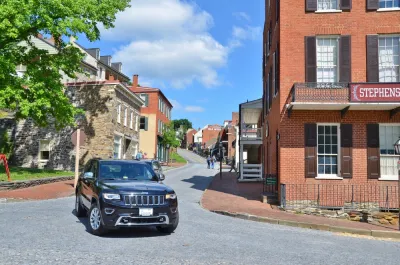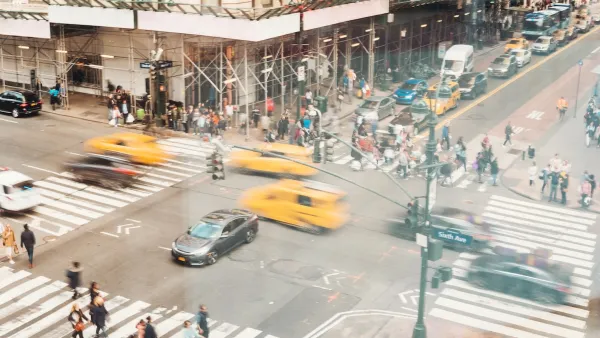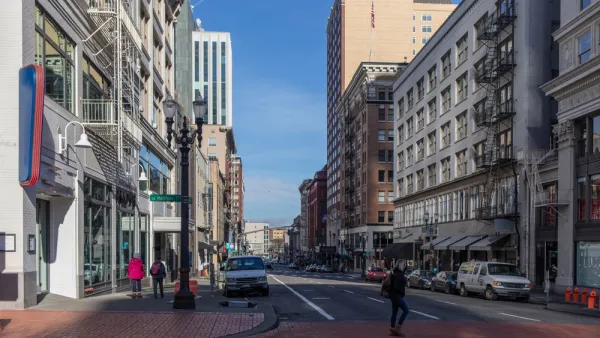Light trucks are killing more pedestrians than ever while keeping their drivers and passengers safer. Is it time to reframe safety regulations?

Despite improvements in efficiency, writes Lloyd Alter in Treehugger, SUVs and pickups still "kill at three times the rate of cars." John F. Saylor's report "The Road to Transport Justice: Reframing Auto Safety in the SUV" assesses safety issues in the design of light trucks and suggests avenues for improvement.
One major problem, Saylor argues, is that safety regulations are designed for "the person who buys the car and is inside, not the person outside." Features that might increase safety for SUV drivers and passengers can also prove deadlier to others. "[I]n a crash between a light truck and a car, car occupants are six times as likely to die than those in the light truck." As light trucks gained popularity, the number of traffic fatalities for people outside of vehicles grew. "Their greater mass and tall, blunt front ends direct greater impact forces to heads and chests; as a result, NHTSA [National Highway Traffic Safety Administration] researchers found that pedestrians are up to three times more likely to be killed when struck by a light truck. This increased risk has led to an incredible 81% increase in pedestrian fatalities involving SUVs between 2009 and 2016."
Meanwhile, the NHTSA "has been increasingly drawn to auto-safety solutions that impose the least burdens on occupants and owners and have a consumer product focus, including recalls covered at manufacturer expense, the NCAP consumer information program, and a growing focus on education efforts to modify pedestrian behavior." This safety crisis also "disproportionately affects women and low-income drivers, who tend to be in older, smaller cars, whereas the SUVs and pickups are more often driven by white men."
Saylor argues that we need "Transportation Justice—a new vision of auto safety where 'the alarming disparate impacts that these externalized dangers create for women, low-income people and people of color demand urgent intervention to ensure that our transportation system does not compound existing inequalities.'" The Biden administration, with its focus on road safety and equity, could present an opportunity to act on vehicle safety measures and "bring NHTSA’s rulemaking in line with transportation justice principles."
FULL STORY: Transportation Justice Paper Calls for 'Dramatic Reframing of Auto-Safety Policy'

National Parks Layoffs Will Cause Communities to Lose Billions
Thousands of essential park workers were laid off this week, just before the busy spring break season.

Retro-silient?: America’s First “Eco-burb,” The Woodlands Turns 50
A master-planned community north of Houston offers lessons on green infrastructure and resilient design, but falls short of its founder’s lofty affordability and walkability goals.

Delivering for America Plan Will Downgrade Mail Service in at Least 49.5 Percent of Zip Codes
Republican and Democrat lawmakers criticize the plan for its disproportionate negative impact on rural communities.

Test News Post 1
This is a summary

Test News Headline 46
Test for the image on the front page.

Balancing Bombs and Butterflies: How the National Guard Protects a Rare Species
The National Guard at Fort Indiantown Gap uses GIS technology and land management strategies to balance military training with conservation efforts, ensuring the survival of the rare eastern regal fritillary butterfly.
Urban Design for Planners 1: Software Tools
This six-course series explores essential urban design concepts using open source software and equips planners with the tools they need to participate fully in the urban design process.
Planning for Universal Design
Learn the tools for implementing Universal Design in planning regulations.
EMC Planning Group, Inc.
Planetizen
Planetizen
Mpact (formerly Rail~Volution)
Great Falls Development Authority, Inc.
HUDs Office of Policy Development and Research
NYU Wagner Graduate School of Public Service





























